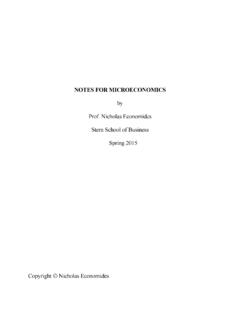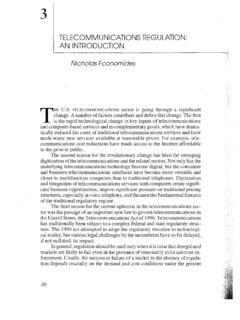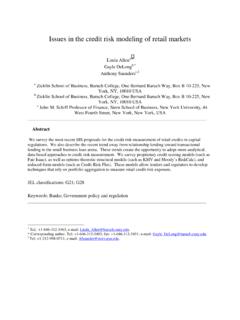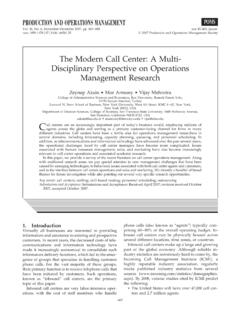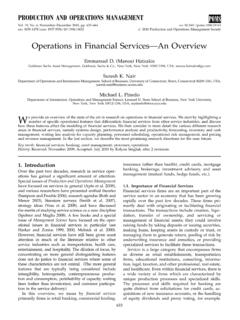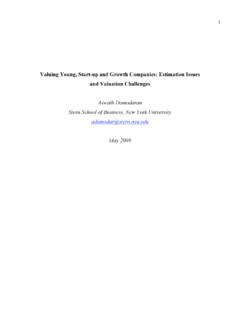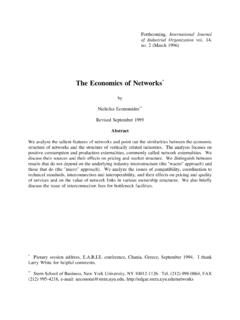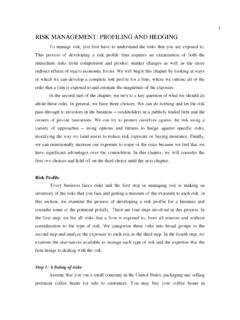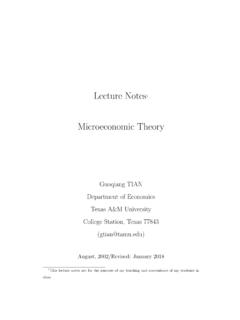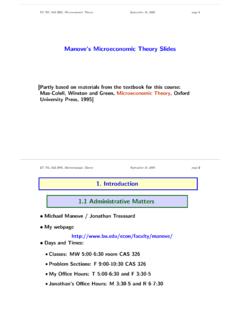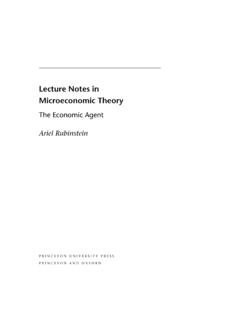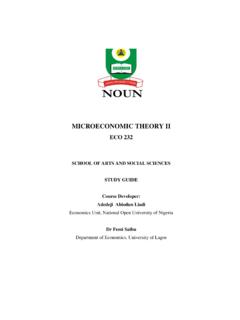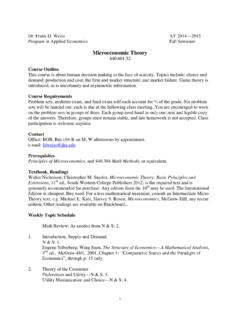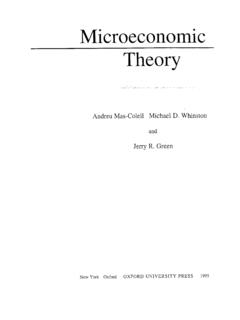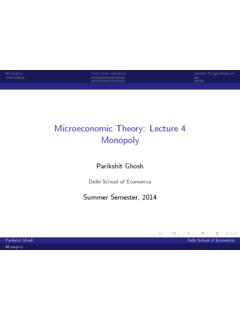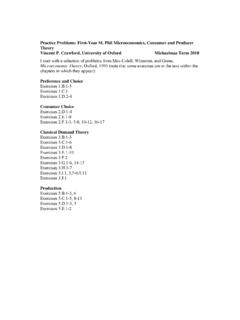Transcription of Advanced Microeconomics - NYU
1 Stern School of Business Advanced Microeconomics Prof. Nicholas Economides Preliminary Outline Spring 2006 M 1:00-4:00 Office Hours: Mon. 5-6pm, Tue. 5-6pm and by appointment, MEC 7-84 Tel. (212) 998-0864, FAX (212) 995-4218 Required Books Jean Tirole, (1989), Industrial Organization, Press. Recommended Books Ken Arrow and Michael Intrilligator, (1981), Handbook of Mathematical Economics, North Holland. Ken Binmore, (1992), Fun and Games: A Text on Game theory , Heath. Augustin Cournot, (1960), Researches into the Mathematical Principles of the theory of Wealth, Kelly, NY (English translation by Bacon). Jim Friedman, (1977), Oligopoly and the theory of Games, North Holland. Jim Friedman, (1983), Oligopoly theory , Cambridge University Press.
2 Jim Friedman, (1990), Game theory With Application to Economics, Oxford University Press. Drew Fudenberg and Jean Tirole, (1991), Game theory , MIT Press. John Harsanyi, (1977), Rational Behavior and Bargaining Equilibrium in Games and Social Situations, Cambridge University Press. David Kreps, (1990), A Course in Microeconomic theory , Princeton University Press. Kelvin Lancaster, (1979), Variety, Equity and Efficiency, Columbia University Press, New York. R. Duncan Luce and Howard Raiffa, (1958), Games and Decisions, John Wiley, Guillermo Owen, (1982), Game theory , second edition, W. Saunders. Eric Rasmusen, (1989), Games and Information, Basil Blackwell. Richard Schmalensee and Robert Willig, (1989), Handbook of Industrial Organization, North Holland. Shapiro, Carl, and Hal Varian, Information Rules, Harvard Business School Press, 1999. Martin Shubik, (1983), Game theory in the Social Sciences: Concepts and Solutions, The Press.
3 John Sutton, Technology and Market Structure (MIT Press, 1998). Carl von Weiszacker, (1980), Barriers to Entry, Springer Verlag. Required reading is indicated by (*) Course Outline I. Review of Game theory (1 week) i. Games in Extensive and Normal Forms 1. D. Luce and H. Raiffa, (1958), Games and Decisions, ch. 3. (*) 2. K. Binmore, (1992), Fun and Games, ch. 1. 3. E. Rasmusen, (1989), Games and Information, ch. 1, 2. 4. D. Kreps, (1990), A Course in Microeconomic theory , ch. 11. ii. Non-cooperative Games 1. D. Luce and H. Raiffa, Games and Decisions, ch. 5. 2. J. Tirole, (1989), Industrial Organization, ch. 11. (*) 3. J. Nash, (1950), Equilibrium Points in n-Person Games, Proceedings of the National Academy of Sciences, vol. 36, at 4. J. Nash, (1951), Non-cooperative Games, Annals of Mathematics, vol. 45, pp. 286-295. 5. G. Debreu, (1952), A Social Equilibrium Existence Theorem, Proceedings of the National Academy of Sciences, vol.
4 38, pp. 886-893. 6. J. Friedman, (1977), Oligopoly and the theory of Games, pp. 152-162, (*) 7. M. Shubik, (1983), Game theory in the Social Sciences, ch. 9. 8. D. Kreps, (1990), A Course in Microeconomic theory , ch. 12. 9. K. Binmore, (1992), Fun and Games, ch. 7. iii. Cooperative Games 1. J. Nash, (1953), Two-Person Cooperative Games, Econometrica, vol. 21, pp. 128-140, at (*) 2. J. Nash, (1950), The Bargaining Problem, Econometrica, vol. 18, pp. 155-162, at 3. L. Shapley, (1953), A Value for n-Person Games, in Contributions to the theory of Games, vol. 2, pp. 307-317, eds. H. Kuhn and A. Tucker, at (*) 4. M. Shubik, Game theory in the Social Sciences, ch. 6, 7. 2II. Oligopoly in Homogeneous Goods ( week) i. Non-cooperative Oligopoly Games 1. Quantity-setting Games a. J. Friedman, Oligopoly and the theory of Games, ch. 1, 2. b. A. Cournot, Researches into the Mathematical Principles of the theory of Wealth.
5 C. J. Friedman, Oligopoly and the theory of Games, ch. 4. d. J. Tirole, (1989), Industrial Organization, pp. 218-228. (*) e. J. Roberts and H. Sonnenschein, (1977), On the Foundations of the theory of Monopolistic Competition, Econometrica, vol. 75, pp. 101-113, at f. J. Roberts and H. Sonnenschein, (1976), On the Existence of Cournot Equilibrium without Concave Profit Functions, Journal of Economic theory , vol. 13, pp. 112-117, at (*) g. W. Novshek and H. Sonnenschein, (1980), Small Efficient Scale as a Foundation for Walrasian Equilibrium, Journal of Economic theory , vol. 22, pp. 243-255. h. W. Novshek, (1980), Cournot Equilibrium with Free Entry, Review of Economic Studies, vol. 47, pp. 473-486, at i. T. Bergstrom and H. Varian, (1985), Two Remarks on Cournot Equilibrium, Economics Letters, vol. 19, pp. 5-8. 2. Price-setting Games a. J. Tirole, (1989), Industrial Organization, pp.
6 205-216. (*) 3. Other Strategy Spaces a. S. Grossman, (1981), Nash Equilibrium and the Industrial Organization of Markets with Large Fixed Costs, Econometrica, vol. 49, pp. 1149-1172, at (*) 4. Mixed Strategies a. H. Varian, (1981), A Model of Sales, American Economic Review, vol. 70, no. 4, pp. 651-659, at , errata at (*) 35. Asymmetric Oligopoly Games. Von Stackelberg Paradigm. Asymmetric Cournot Games. a. A. Dixit, (1979), A Model of Duopoly Suggesting a theory of Entry Barriers, Bell Journal of Economics, vol. 10, pp. 20-32, at (*) b. W. Novshek, (1984), Finding All n-Firm Equilibria, International Economic Review, vol. 25, no. 1, pp. 61-70. ii. Collusion, Coordination and Coalition Formation 1. Donsimoni, N. Economides and H. Polemarchakis, (1986), Stable Cartels, International Economic Review, vol. 22, no. 2, pp. 317-327, at (*) 2. M. Perry and R. Porter, (1985), Oligopoly and the Incentive for Horizontal Merger, American Economic Review, vol.
7 75, 219-227. 3. C. D Aspremont and J. Jaskold-Gabszewicz, (1986), On the Stability of Collusion, in J. Stiglitz and C. F. Mathewson (eds.) New Developments in the Analysis of Market Structure, MIT Press. III. Oligopoly in Differentiated Products (2 weeks) i. Variety Differentiation 1. Duopoly a. H. Hotelling, (1929), Stability in Competition, Economic Journal, vol. 39, pp. 41-57, at (*) b. C. D Aspremont, J. Jaskold-Gabszewicz and Thisse, (1979), On Hotelling s Stability in Competition , Econometrica, vol. 47, pp. 1145-1150, at (*) c. N. Economides, (1984), The Principle of Minimum Differentiation Revisited, European Economic Review, vol. 24, pp. 345-368, at (*) d. J. Tirole, (1989), Industrial Organization, pp. 277-282. (*) e. N. Economides, (1986), Nash Equilibrium Existence in Duopoly with Products Defined by Two Characteristics, Rand Journal of Economics, vol. 17, no.
8 3, pp. 431-439, at 2. Oligopoly a. K. Lancaster, (1979), Variety, Equity and Efficiency. 4b. S. Salop, (1979), Monopolistic Competition with Outside Goods, Bell Journal of Economics, vol. 10, , at (*) c. W. Novshek, (1980), Equilibrium in Simple Spatial (or Differentiated Product) Models, Journal of Economic theory , vol. 22, pp. 286-295. d. N. Economides, (1989), Symmetric Equilibrium Existence and Optimality in Differentiated Products Markets, Journal of Economic theory , vol. 47. no. 1, pp. 178-194, at (*) e. J. Tirole, (1989), Industrial Organization, pp. 282-289 (*) f. A. Dixit and J. Stiglitz, (1977), Monopolistic Competition and Optimum Product Diversity, American Economic Review, vol. 67, pp. 297-308, at g. J. Tirole, (1989), Industrial Organization, pp. 298-300. h. M. Spence, (1976), Product Selection, Fixed Costs and Monopolistic Competition, Review of Economic Studies, vol.
9 43, pp. 217-236, at (*) i. M. Spence, (1976), Product Differentiation and Welfare, American Economic Review, Papers and Proceedings, vol. 66, no. 2, pp. 407-414, at j. O. Hart, (1985), Monopolistic Competition in the Spirit of Chamberlin: A General Model, Review of Economic Studies, vol. 52, pp. 529-546. 3. Sequential Decisions a. E. Prescott and M. Visscher, (1977), Sequential Location Among Firms with Foresight, Bell Journal of Economics, vol. 8, pp. 243-248, at (*) b. N. Economides, J. Howell and S. Meza, (2002), Does it Pay to be First? Sequential Locational Choice and Foreclosure, Discussion Paper EC-02-19, Stern School of Business, , at (*) 4. Informational Advertising; Market Failure; Moral Hazard a. G. Grossman and C. Shapiro, (1984), Informative Advertising with Differentiated Products, Review of Economic Studies, vol. 1, 63-82. b. J. Tirole, (1989), Industrial Organization, pp.
10 289-295, 106-126. (*) 55. Multi-product Firms a. A. Shaked and J. Sutton, (1990), Multiproduct Firms and Market Structure, Rand Journal of Economics, vol. 21, no. 1, pp. 45-62, at ii. Quality Differentiation 1. Perfect Competition and Monopoly a. S. Rosen, (1974), Hedonic Prices and Implicit Markets: Product Differentiation in Pure Competition, Journal of Political Economy, vol. 82, pp. 34-55, at (*) b. M. Mussa and S. Rosen, (1978), Monopoly and Product Quality, Journal of Economic theory , vol. 18, pp. 301-317, at (*) c. J. Jaskold-Gabszewicz, A. Shaked, J. Sutton and Thisse, (1986), Segmenting the Market: The Monopolist s Optimal Product Mix, Journal of Economic theory , vol. 39, pp. 273-289, at . d. N. Economides, (1995), The Incentive of a Multiproduct Monopolist to Provide All Goods, Discussion Paper no. EC-95-09, Stern School of Business, 2. Duopoly a. A. Shaked and J.
